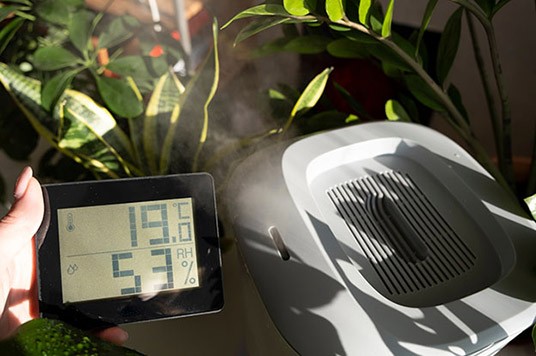Humidity control for plants growing indoors
Plants only grow successfully if the humidity of your grow room is exactly right. This means humidity affects the yield of your indoor plants. By regulating the amount of the water vapor in the air, you also make sure that molds like mildew and botrytis (bud rot) do not stand a chance.

What is humidity?
Humidity is the amount of water vapor in the air of your grow room. It is not to be confused with relative humidity, which also takes into account the maximum amount of water vapor that could be available at any given temperature.
What does humidity do for indoor plants?
Plants evaporate water in order to cool themselves and to discharge waste. Humidity impacts the amount of water plants can evaporate through their leaves. If the humidity for indoor plants is too high at a low temperature, plants cannot get rid of their water vapor. This stops the evaporation process. If this is the case, plant roots can no longer take on new nutrients as there is no room for them. Therefore, you should always use a good ventilation system when growing indoor plants. This helps discharge the warm, humid air and promotes the supply of fresh air.
If the humidity is too low at a high temperature, plants evaporate too much water instead. They will try to make up for this loss by absorbing more water with their roots. This means they also receive more nutrients and may lead to what is called a nutrient burn. A nutrient burn first leads to burned leaf tips and may end with dying flowers and withered leaves.
Humidity control of indoor plants
The ideal humidity of your plant depends on the phase it is in. Cuttings and young plants require a high humidity. This is because their roots are still developing. This requires a lot of water. We recommend a humidity of 80 to 85 percent. As your plant grows you should lower the humidity. In the last weeks of the grow stage we suggest a maximum humidity of 60 percent. During the flowering stage of the plant, it is important that you keep the humidity below 50 percent. This way you prevent fruits from rotting. Keep in mind that the perfect weekly humidity depends on the plant species. On the internet you will find plenty of VPD (Vapour Pressure Deficit) charts for the ideal humidity during the cycle of your specific plant species.
How to lower or increase humidity?
Humidity has a large effect on plants then, but how can you influence it? A humidifier is an inexpensive and easy way to increase humidity. You can also leave a wet towel in your grow room. If you are trying to lower humidity, you should use an ventilation system to exhaust more air. Another option is to use a fan or dehumidifier.
Humidity indoor plants - video
Rather watch a video? We've made one for you with a simple explanation without too many technical details. Use this link to watch the video.
Growing plants indoors and Plagron fertilisers/soils
If you are a starting grower and you grow plants indoors, we recommend to use Plagron products from the 100% TERRA range. You grow on peat (Plagron Lightmix or Plagron Growmix) with base nutrients Terra Grow and Terra Bloom. Do you need some help with dosage? Download our 100% TERRA grow schedule. You need help during your cycle? Contact our Grow Experts on servicedesk via: servicedesk@plagron.com.



